
Zigbee, Z-Wave, Alexa, Google Assistant, HomeKit, SmartThings, Matter, Thread and more
A proper smart home needs a smart home hub – don’t let anyone tell you otherwise.
When you’re blending smart home devices from a bunch of different manufacturers, you need a home automation hub to get them all working together, and all controllable within one app – even with Matter potentially making things a bit easier in the future.
While the demise of the smart home hub has been much talked about, the reality is a little less clear. The fact is, hubs can take many forms; you may already own a smart home hub and, in a dramatic end-of-season twist, you may not need to buy anything at all.
Home hubs often conjure images of white boxes connected to your router, but some Echo and Google Nest smart speakers can step in to help, as well as the likes of Apple TV boxes and even Samsung TVs and fridges…. yep, fridges.
It all depends on what tech you want to connect – and how you want to do it. You’ll need to navigate the waters around protocols such as Zigbee, Z-Wave, Alexa, Google Assistant, HomeKit, SmartThings, Matter, Thread and more.
And it can get confusing. Don’t worry, though, because that’s where this guide can help.
Scroll down to get clued up on the best smart home hubs, including the all-important details on exactly what they do and our in-depth reviews.
Best smart home hubs
Here are our picks for the best smart home hub for your home.
Whether you’re just starting out or already committed to an ecosystem – we have the right hub for you.
Best overall smart home hub: Aeotec SmartThings Hub
- Connectivity: Wi-Fi, Ethernet, Bluetooth, Zigbee, Z-Wave, Matter, Thread.
Samsung-owned SmartThings is an incredibly popular ecosystem, and, although the Korean company used to make hardware in-house, it has now shifted the SmartThings device manufacturing process to third parties.
Now, with the Samsung-branded v3 Hub in very short supply – you’ll struggle to find it on sale anywhere – people do have another option – Aeotec’s SmartThings Hub is essentially the v3 but with different branding.
The latest SmartThings base is a versatile hub, supporting a broad range of devices thanks to both Zigbee and Z-Wave integration and an open approach.
It’s also now capable of being both a Matter controller and a Thread border router, so it’s pretty future-proof as well.
There’s work to be done on general SmartThings usability, and the app situation needs some finessing (despite a few welcome updates in the past couple of years), but those who own a lot of products from different manufacturers may be able to overlook these shortcomings.
SmartThings’ biggest strength is its versatility: it is the most compatible hub out there and it integrates with both Alexa and Google Assistant, so you can control all your connected devices and scenes using voice.
Once it’s all set up and connected, SmartThings works great and it remains one of the most comprehensive smart home systems.
Be aware though that Samsung is definitely moving towards a hub-less setup for SmartThings, with hubs being built into smart TVs, soundbars, monitors and even fridges.
None of those hubs are, at least not yet, as comprehensive as the dedicated Aeotec hub though – so it still remains the top option for a SmartThings controller.
What we love
- Z-Wave and Zigbee on board
- Works with hundreds of brands
- Matter controller with Thread border router
- Ethernet and Wi-Fi
What we don’t love
- Fiddly to migrate from older SmartThings hub
- Pretty old now
Read our full Aoetec SmartThings Hub review to find out more.

Best Alexa smart home hub: Amazon Echo Hub
- Connectivity: Wi-Fi, Bluetooth, Zigbee, Matter, Thread, Amazon Sidewalk.
Amazon’s Alexa ecosystem is finally a viable smart home system to run your entire setup on, especially since the tech giant started packing Zigbee connectivity into its smart speakers.
The Works with Alexa platform’s incredible reach and array of support make it the best option for those who just want to get control of their multiple devices.
There are precious few smart home devices that don’t have an Alexa skill and Amazon’s voice assistant will easily hoover up control of your devices, the groups and scenes work like a dream, and you can use the app to control things as well as your voice.
Alexa also lets you create Routines that run based on the time of day, voice commands, device-based Routines, geolocation-based routines, and Echo Button-based Routines, helping all your devices work as one.
While you can run Routines and control your smart home devices on any Echo smart speaker, the best dedicated device is the Amazon Echo Hub; the clue is in the name.
The Amazon Echo Hub is essentially a modded Echo Show 8, designed to sit flush on your wall. The key difference is that, although there are some nice smart home control widgets on the Show range, they all live behind the entertainment aspects – on the Echo Hub they are front and center.
It has Zigbee support built in, so you can directly pair with a range of devices including the likes of Philips Hue lights, and even sensors like those from SmartThings or Ring Alarm, straight to your Echo Hub.
And, with Matter and Thread on board, it’s now the most complete Echo smart hub package.
The 4th Gen Echo also has Matter, Thread and Zigbee on board, if you don’t want a screen. But the screen gives you a handy interface to control your devices and view live video footage from your cameras or video doorbell, which you don’t get with the Plus.
For tips on how to use Alexa as your smart home hub read our guide to setting up your Alexa smart home and our guide to using Alexa Routines.
What we love
- Alexa
- Works with practically everything
- Simple to use and set up, for humans
- Zigbee support
- Thread and Matter
What we don’t love
- Routines can be unreliable
- The Alexa app is clunky
- Zigbee Echo devices are more expensive
- No Z-Wave
Read our full Amazon Echo Hub review to find out more
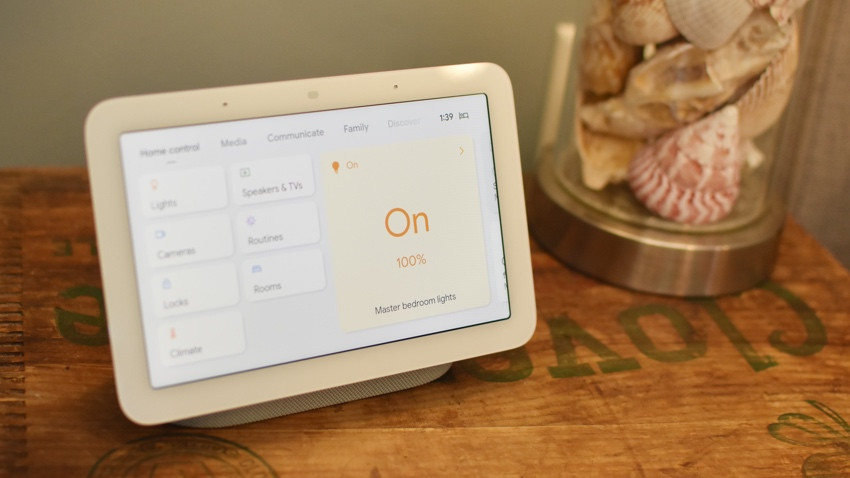
Best Google smart home hub: Google Nest Hub (2nd-gen)
- Connectivity: Wi-Fi, Bluetooth, Matter, Thread
Google hasn’t launched a new hub for a few years now and, if you’re all in with a Google Home, the Nest Hub still remains your best bet, despite its age.
However, you can use voice commands, touch and time to have all your gadgets respond, and there are a lot of gadgets that work with Google.
Google is also your best choice if you have older Nest products such as the Nest Thermostat, Nest Protect smoke alarm, Nest Hello Doorbell and Nest Secure alarm system, and, obviously the crop of newer Google Nest-branded products.
Google Nest Hub’s Home View, which is a top-down look at your entire smart home, gives you great touch controls for quick access to any connected lights, locks, video streams and thermostats, so no need to use voice or get your phone out if you don’t want to. Plus, it’s an excellent digital photo display and integrates seamlessly with your Google calendar.
Nowadays, Google has its Works With Google program, which lets you control thousands of smart home systems and devices through the Google Home app and Google smart speakers using Google Assistant voice commands.
You can turn off lights, adjust your thermostat, lock your door, or have all those things happen at once with a single command, using Google’s Routines.
There are still a lot of limitations, however, and many of those bajillion integrations are very limited. But the Google Nest Hub is a good, simple interface for managing your home and your digital life and will likely only get better.
The Nest Hub also packs in a Thread radio and Google has also enabled it to be a Thread border router, now that the Matter smart home ecosystem has arrived.
What we love
- The smaller size
- Google’s Home View
- Doubles as a photo frame when not in use
- Cheaper than ever
What we don’t love
- No Zigbee/Z-Wave support
- Alexa still has more compatibility
Read our full Google Nest Hub review.

Best HomeKit hub: Apple TV 4K 2022 (128GB)
- Connectivity: Wi-Fi, Ethernet, Bluetooth, Matter, Thread
The Apple TV 4K (2022), promises performance boosts, a USB-C Siri Remote and support for HDR10+; all with a cheaper price tag than the previous generation.
And the reason we’ve been so specific in naming the 128GB model is that it is both a Matter controller and a Thread border router. The 64GB version lacks Thread. The 2021 model also packs both though, so you may not need to upgrade.
Apple’s HomeKit falls between a software hub and a traditional hub; there’s a small box-like device you need if you want to control your devices while you’re out of the house and that runs Automations for you, but you can also just use your iPhone to control any HomeKit compatible devices.
To get the proper HomeKit experience, though, you need that box, and the Apple TV is the best hub for the job, as you can use its Remote to summon Siri and it does double duty as a truly excellent set-top streaming box. There’s also an Ethernet port (which you don’t get on the HomePod or iPad) for a more reliable connection.
There’s no Zigbee or Z-Wave here, pretty much everything runs over Bluetooth and Wi-Fi, and you’ll need separate ecosystem hubs to connect devices like Phillips Hue light and WeMo products.
However, HomeKit’s ecosystem is growing and there are a lot more products now, enough to make a pretty decent setup. Plus, as HomeKit is baked into iOS, there’s no confusing new system to learn to use, and you have lots of options for controlling your devices – your iPhone, Apple Watch, Mac computer, and of course Siri for voice control through any of those devices.
Setting up Automations and Scenes in HomeKit is really easy to do, and because most of the communications are locally based (meaning they don’t have to go to the cloud for processing), it’s one of the snappier smart home hubs we’ve tested. For more on HomeKit read our guide to setting up an Apple smart home.
As we mentioned at the top of this section, there’s really no reason to buy the 2021 model of Apple TV now that the cheaper, more advanced version has been launched. Still, if you do happen to find this 2021 model at a really reduced rate, it does pack in a Thread radio and can act as a Thread border router, so, in terms of home hub capabilities, you’re not missing out.
What we love
- The visual HomeKit experience
- Ethernet port
- It’s also a great 4K streaming box
What we don’t love
- HomeKit support is still relatively small
- HomePod mic is better
- 64GB version no Thread
Read our full Apple TV 4K review.
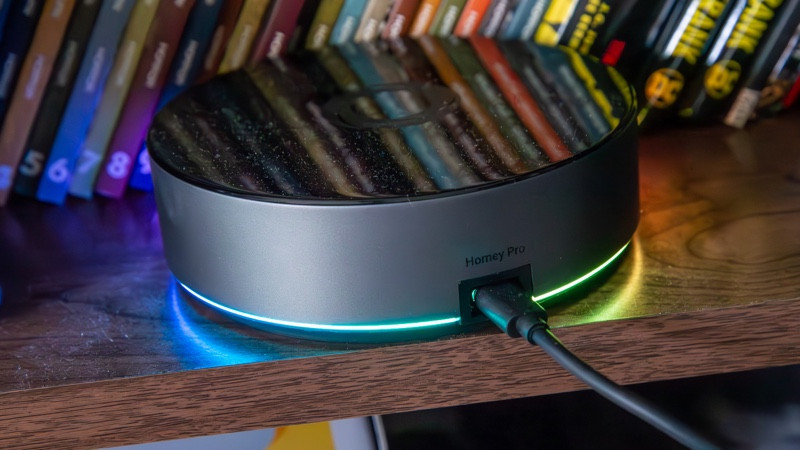
Best smart home hub for enthusiasts: Homey Pro
- Connectivity: Wi-Fi, Zigbee, Z-Wave, Infrared 433MHz / 868MHz, Bluetooth, Thread.
With Samsung SmartThings moving to a new platform that has killed off its more powerful plugins, such as WebCORE, where should the true smart home enthusiast that likes to tinker go to? Homey, of course.
The Homey Pro (Early 2023), to give it its full moniker, is – as we mentioned already – the 2nd-generation Pro model but is actually the 5th iteration of Athom’s smart home controller.
If you want to build out you home with Zigbee and Z-Wave devices now, with the potential for Matter and Thread in the future, then there’s no other system that quite offers the power that Homey Pro does, certainly not since SmartThings changed so radically.
If Homey Pro supports the devices you want and you need more powerful automations than its rivals can offer, there’s nothing better.
It’s pretty expensive and you can get the latest SmartThings hub for around a third of the price, which does around 90% of what the Homey Pro is capable of.
However, Homey’s new top dog is aimed squarely at those people who want to tap into that extra 10% and if that’s you then you will be well served.
Be aware, in July 2024 LG acquired Homey’s parent brand Athom so the platform may well evolve and change in the coming months and years.
What we love
- Powerful automation
- Nice organisation
- Zigbee, Z-Wave, Bluetooth, IR and cloud support
- Built for enthusiasts
What we don’t love
- Expensive
- No Thread yet
- 3rd-party apps sometimes fiddly
Read our full Homey Pro review.
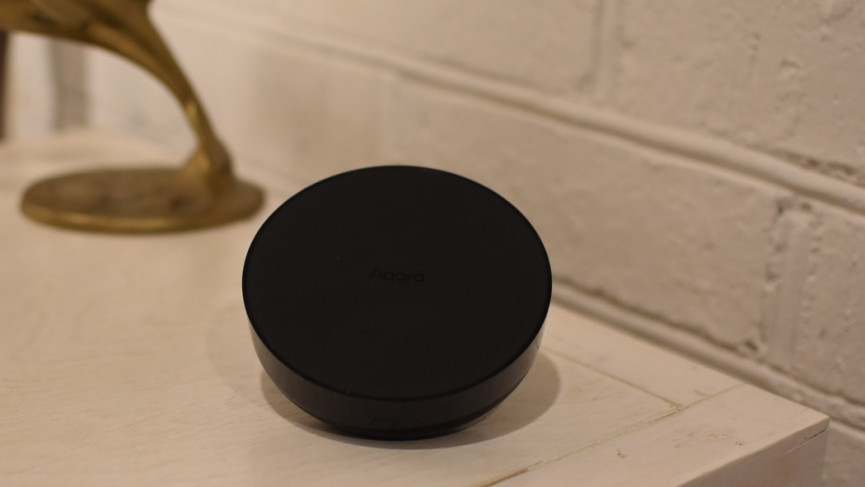
Best budget Hub: Aqara Hub M2
- Connectivity: Wi-Fi, Ethernet, Bluetooth, Zigbee, Matter, Thread
Aqara is becoming a major player in the smart home space, with its low-cost, high-quality devices on offer to fill every nook and cranny of your smart home.
Offering a wide range of devices, from motion sensors to smart switches, Aqara’s products work with Apple HomeKit, Amazon Alexa, and Google Home.
The Aqara system revolves around a Zigbee smart home hub, of which there are three, and is a decent and growing ecosystem of products. The M2 is a great option at a great price.
A Zigbee-based system, the M2 works with Alexa, HomeKit, and Google Assistant, and can expose all of Aqara’s battery-powered sensors and smart gadgets to your voice-controlled smart home system of choice (or Aqara’s own in-house system and app).
Aqara hubs can accommodate up to 128 “child” devices. However, you can only add 32 “terminal” devices (battery-powered sensors, buttons), before you’ll need a Relay device to add 16 more. A relay device is always powered and in the Aqara system is any wall switch with a neutral wire.
The M2 also has a speaker that can double as a siren if you choose to set up your Aqara system as a self-monitored alarm.
It also has an IR transmitter built-in, so you can use it as a replacement for any IR remote you may have for a TV, fan, or game console.
The M2 can also bring all of your Aqara devices into a Matter smart home system too.
As well as the M2, Aqara also has a bunch of other smart home hubs available for its ecosystem, including the M1S, the Aqara Hub E1 and even hubs that have security camera skills such as the Aqara Camera Hub G3.
Bear in mind that none of the other hubs have Matter support yet though.
There is also the Aqara Hub M3, which – in theory at least – adds native Matter controller skills to the mix. However, in our testing of the device we’ve found a lot of flaws with Aqara’s supposed flagship so our recommendation remains the M2.
What we love
- Works with all ecosystems
- Affordable
- Built-in siren
What we don’t love
- The native app is clunky
- The security system is a bit buggy
Read our full Aqara smart home review
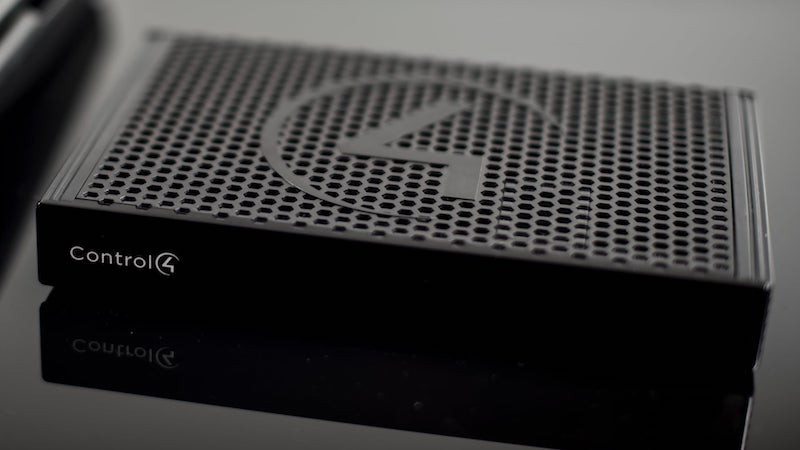
Best professional smart home hub: Control4
- Connectivity: Wi-Fi, Ethernet, Bluetooth, Zigbee, Z-Wave and many more
Control4 specializes in bespoke connected systems for houses, hotels, business premises, and more, with only authorized dealers able to install and configure the setups.
It’s a high-end offering that costs a lot more than kitting your house out with the do-it-yourself smart home hubs we’ve discussed. But at the same time, Control4 offers reassurance to its customers that they’re getting a best-in-class system, with a support network in place for any issues or alterations.
A Control4 system can be configured to control lighting, multi-room audio, HVAC systems, security systems, smart locks, and more. It uses the likes of Zigbee, Z-Wave, Wi-Fi, and Bluetooth and is compatible with over 35,000 devices from a huge collection of brands.
Control4 is designed for people that have serious money to spend on a high-end smart home automation hub, while at the same time having no interest in dirtying their hands by building their own DIY system.
High prices aside, however, it offers its customers absolutely world-class tech in a rock-solid, expert-supported, system. If you’re looking for the very best home network or a premium audio experience, Control4 has you more than covered.
What we love
- High-end devices
- Amazing customer service
- Slick looking controllers
- Evolving system
What we don’t love
- Very, very expensive
- Locked-down system
- Limited user configurations
- The smart doorbell isn’t great
Read our full Control4 review.
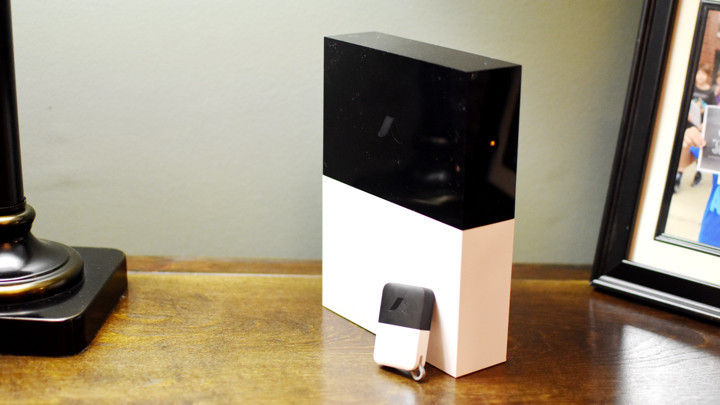
Best smart home hub with security: Abode Iota / Essentials Gateway
- Connectivity:Wi-Fi, Ethernet, Bluetooth, Zigbee, Z-Wave, abodeRF
Abode has two versions of its security system, the Essentials Gateway (2nd gen) and the Iota – both of which have plenty of smart home bug skills thanks to 4G cellular radios, Z-wave 500 series chips, a Zigbee radio; plus six-hour battery backup and a microSD card.
The Iota can work on Wi-Fi, while the Gateway needs to be connected to a router via Ethernet.
These are high-end smart security systems first and foremost, with smart home hub functions second. They’re not a perfect assimilation of the two, but it’s one of the best attempts so far. The integration with Alexa and being able to trigger Alexa Routines with Abode sensors is a big step in the right direction.
It integrates with Google Nest, Philips Hue, Ecobee and Lifx, and you can connect up to 160 Zigbee and Z-Wave devices to it.
Additionally, the proprietary abodeRF radio in the Abode hubs has a range of 1,000 feet, much further than most systems we’ve tested, so even in larger houses you should be able to get a reliable connection between sensors and hub without needing a mesh network or extenders.
CUE automation, which you set in the app, is IFTTT-style automation that lets you tailor the system to your lifestyle.
What we love
- Great security system
- CUE automation is great
- Easy installation
- Z-Wave and Zigbee on board
What we don’t love
- Smart home hub features play second fiddle
- App is a little bit clunky
- Extra security components are pricey
Read our full Abode security system review.
Other smart home hubs worth considering
The hubs listed above are our current top picks but they are by no means the only options. Here are some other models you may want to consider for your smart home setup.
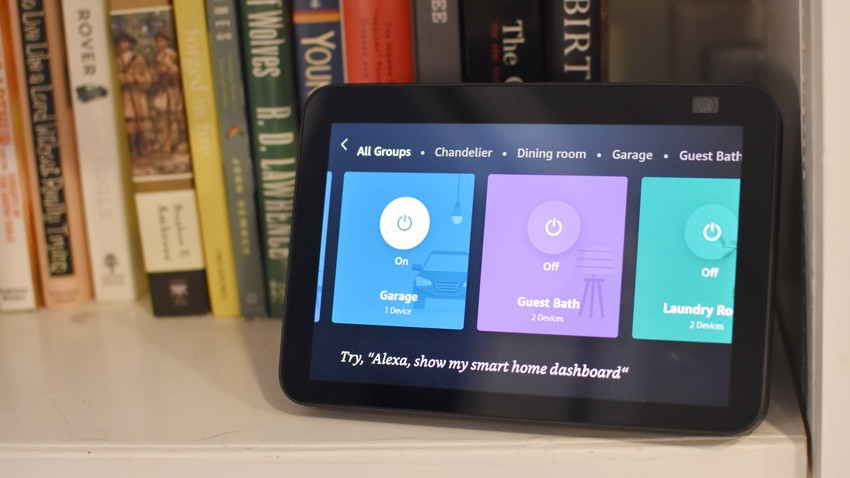
What does a smart home hub do?
If you have multiple smart home gadgets in your house from a variety of different manufacturers you’ll want some way of making them work together – enter the smart home hub.
A good example is smart bulbs. You’ve somehow amassed a collection from three different manufacturers and want them all working in the same room, controlled as one – you need a smart home hub.
A smart home hub’s primary purpose is to talk to the internet on behalf of all your devices, giving you the ability to control your house when you’re away (over the internet).
If you want to turn your heating on from the office before you return home, or schedule your lighting when you’re on holiday, you’re going to need something to offer remote and secure access to your stuff… essentially something that has a Wi-Fi connection so it can communicate with your smartphone.
A hub works by helping your devices talk to each other, acting as a translator for all their different languages (or protocols), including Zigbee, Z-Wave, Thread, Bluetooth, Wi-Fi and others.
For example, with a SmartThings hub you can set up a motion sensor by your front door that works over the Z-Wave protocol, and when it senses motion it can tell the Samsung SmartThings hub, and the SmartThings hub can tell your smart bulbs on the Zigbee protocol to turn on.
These devices can’t talk directly to each other as they’re small and in some cases battery-powered. Having multiple radio protocols jammed into them would make them bulky, power-hungry devices.
So, instead of giant sensors and ugly smart light bulbs, one small hub packs all the radios and does all the communicating – it’s like a switchboard for your home.
Compatibility with Matter and Thread
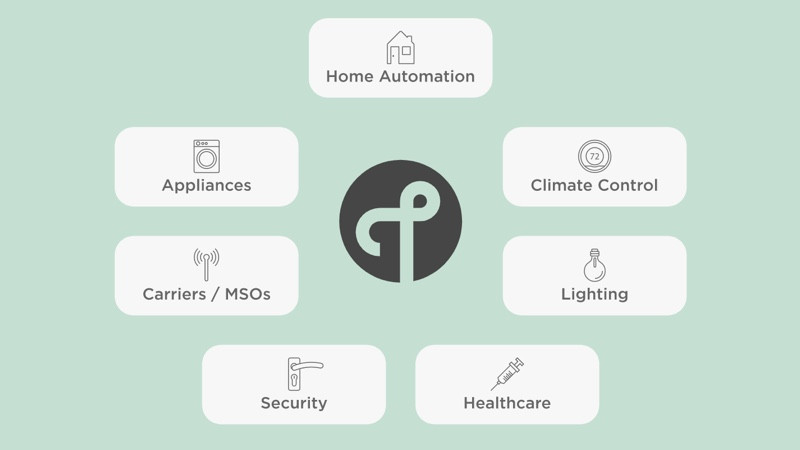
Throughout this guide, we’ve been referencing both Matter and Thread – and their importance.
Put simply, any smart home hub worth its salt going forward will be compatible with Matter.
But what exactly is Matter? Well, in short, it’s a collaboration between some of the biggest players in tech – Apple, Google, Amazon, Samsung, the Zigbee Alliance, and various other tech brands – to create a unified smart home standard.
It means compatible devices play nicely with one another, and users won’t have to be locked into one ecosystem until the end of time (or until they buy a hub from each manufacturer).
Explainer: What is Thread for the smart home
This does make the notion of a traditional home hub a little shaky, as we touched upon in the intro, but, in truth, these are often now versatile devices in their own right. Also, really, the next generation of ‘hubs’ will just be any smart home device that can act as a Thread border router.
With Matter now rolling out and becoming more common, Thread has never been more important. As the super low-power protocol that will help Matter devices talk to each other, it is playing a major part in this movement – although there have been some issues.
If this is all sounding like another language to you, though, let’s clear up a bit more about Thread’s role.
What is a Thread border router?
In the world of Matter, ‘hubs’ are essentially devices that can act as Thread border routers.
As you might have already guessed, these work in a fairly similar way to a traditional smart home hub – essentially representing the way devices in your Thread mesh network can access the local Wi-Fi network, cloud and ethernet. This router, then, sits on the ‘border’ of the network and joins it to the wider world – a bit like your standard Wi-Fi router.
They also come in plenty of different forms, as you’ll have gathered from the best options listed above. Some double up as streaming boxes, some are smart displays and others are screenless speakers.
There’s a decent chance you may already have one in your home, or you may have to try and incorporate a device with a Thread radio in the future.
How do I choose a hub?
There are three types of smart home hubs: traditional radio-packed hubs, voice-assistant hubs and software-only hubs.
You may need just one type, possibly two, and if you’re going all in – maybe three. Here’s what each type does:
Traditional smart home hubs
The likes of Samsung’s SmartThings, Homey and Hubitat are hubs equipped with all the protocols and software required to suck up any device and let you control them all from one app.
While these seem like a one-stop solution to all the smart home’s problems, there are a couple of issues. For example, just because you’ve gone out and invested in SmartThings doesn’t necessarily mean you now have one hub to rule them all.
Many ecosystems only work with their own hub in place, and not all products are “supported” by every hub – even if they have compatible radios.
There are workarounds, but that’s where things get complicated, which is where traditional hubs fall down in general, they have a pretty steep learning curve.
Voice Assistant Hubs
Smart speakers such as Amazon Echo and Google Home are quickly becoming viable smart home hubs, in large part because they are much simpler to use. What’s easier than voice?
However, these can’t handle the more complex automations traditional smart home hubs tackle with ease. Instead of relying on radios to read the device’s protocols, smart speakers use software through their Works with Alexa and Works with Google Assistant programs to connect your gadgets.
Once devices are under the spell of Alexa or Google, you can start taking control of them via voice, as well as Groups and Scenes. That means you can group devices and control them with a single command.
Amazon launched the Echo Plus with a Zigbee radio inside a few years ago and has put the Zigbee hub inside subsequent Echo smart speakers such as the 4th-gen Echo, the Echo Show 8, the Echo Hub and the Echo Show 10.
This makes them a hybrid between a Voice Assistant and a Traditional hub. The benefit here is you can get rid of some of the ecosystem hubs brands like Philips Hue use, as you can connect Zigbee devices right to your Echo.
Software-only hubs
You don’t always have to buy a new piece of hardware for your home – there are some apps out that can take on the role of a hub. This will cover the job of unifying different devices on your smartphone, reducing the need to delve into multiple apps to control elements of your home. The one caveat here though, is that some services only work when you’re in your home.
Apple HomeKit is a software hub and a hardware hub. HomeKit devices can plug into your Apple Home app no problem, regardless of needing a hub or not, and you can control them with Siri or your iPhone. But if you want remote access you need one of Apple’s always-on hardware hubs – an iPad, Apple TV or HomePod.
For broader compatibility, and if you have an Android phone Yonomi has the power to control a heap of devices. You don’t need any hardware, just a bit of patience to get the app set up properly. It’s pretty powerful too.
Ecosystem hubs
A quick mention is needed here about the fourth type of hub. Most mini-ecosystems (Hive, Tuya, Philips Hue, LightwaveRF to name but a few) come with their own hub (sometimes called a Bridge). That’s because they run on protocols such as Zigbee or Z-Wave that require an extra device to sort everything else.
That doesn’t apply to all devices, because for better or worse, many use Wi-Fi to communicate, so no hub is necessary – Lifx is one such example. In general, you will need to use another smart home hub in addition to your ecosystem hub to have a fully-fledged smart home
How to choose your ecosystem
Still confused, unsure what ecosystem to go all-in on? We’re here to help. Read our guide to the best smart home ecosystems for a deeper dive on all the above platforms, and more.







